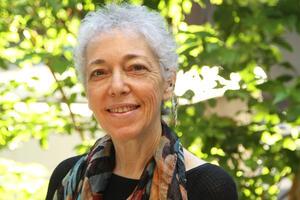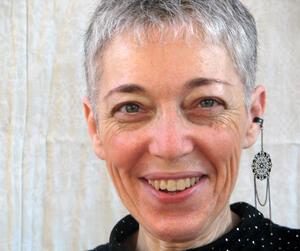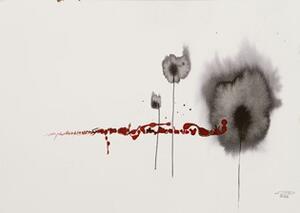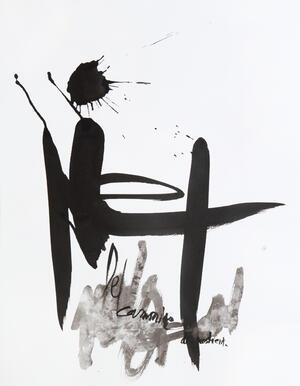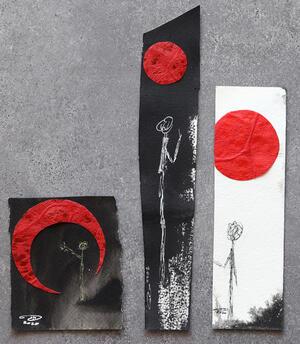Hagar Kadima
Composer and visual artist Hagar Kadima was the first Israeli woman composer to earn a Ph.D. in composition, from the University of California-Santa Barbara in 1988. Kadima has composed more than 70 orchestral, choral, chamber, vocal, and solo compositions, which have been performed and aired in Israel and abroad. In 2000, she founded the Israeli Women Composers Forum and served as its first chair. Her vocal works, especially during the 2000s and 2010s, reflect both Israeli identity and feminist themes. In 2010, Kadima embarked upon a second career as a painter. Her works were selected for approximately 30 exhibitions throughout Israel during the 2010s. As an ink artist, who also has integrated free expressive calligraphy, her mostly abstract works have been often inspired by feminist poetry.
Composer and Visual Artist
Composer and visual artist Hagar Kadima was the first Israeli woman composer to earn a PhD in composition. In 2000, she founded the Israel Women Composers’ Forum (IWCF), which she chaired until 2005. Prior to this time, few connoisseurs could have named more than a handful of significant Israeli women composers. Indeed, as of the early 1990s, out of about two hundred Israeli works performed by the Israel Philharmonic Orchestra (founded in 1936), only approximately five were composed by women. Moreover, until 2000, barely five percent of performances, broadcasts, recordings, and commissions of contemporary music were by women composers. Only in 2002 did a woman composer, Betty Olivero, serve as a faculty member of composition at an Israeli academic institution.
Led by Kadima, the IWCF’s activities—concerts of music by women composers, collaborations with visual and other performing women artists, dissemination of information on women composers through the media—have increased the recognition of many of the approximately forty women composers who joined Kadima’s project in 2000, as well as of about a hundred women composers of art (concert) music throughout Israel as of the early 2020s. In the 2010s, the IWCF was renamed “The Israeli Women Composers & Performers Forum.”
From 1990 to 2014, Kadima was a lecturer at the Levinsky College of Education, Faculty of Music Education, where she taught ear training, harmony, and composition. She has composed more than 70 orchestral, choral, chamber, vocal, and solo compositions. Approximately 30 of them were written during the 2010s, parallel to a momentous shift in her career.
In 2010, Kadima reshaped her life, this time as a painter, a rare shift among her composer colleagues. Her works have been selected for about 30 exhibitions throughout Israel. As an ink artist, who has also integrated free expressive calligraphy, her abstract works have often been inspired by poems with feminist undertones, which she expressed in her paintings through the dramatic juxtaposition of ethereal lines and gentle clouds of colors with bold lines, structures, and penetrating, dark colors.
Musical Biography
Kadima was born on May 23, 1957, in Haifa. She has composed music since her adolescence, when she studied the piano with Naomi Meiron. At the Rubin Academy of Music, Tel-Aviv University (today, the Buchmann-Mehta School of Music at Tel Aviv University), she studied composition with Abel Ehrlich, her most influential teacher. Other composers by whom she was inspired were Olivier Messiaen, György Ligeti, and Mordecai Seter. In 1981, Kadima earned two B.A. degrees, both cum laude, in music and in philosophy from Tel Aviv University. She attended the 1985 Aspen Music Festival and School, taking classes with Luciano Berio, Jacob Druckman, and Bernard Rands, and completed her M.A (1983) and Ph.D. in composition at the University of California at Santa Barbara (1988), studying with Edward Applebaum and Emma Lou Diemer.
Kadima has won a number of prizes and awards, including the 1984 annual ACUM Prize, the Rostrum competition (European Radio, 1987), and the Israel Prime Minister’s Composition Prize (2003). She has represented Israel internationally in the Aspekte Salzburg Festival (1990); in the International Society for Contemporary Music (ISCM) festival in Warsaw (1992); and in Ireland (1995) as part of an Ireland-Israel cultural exchange. During the summer of 1996, she was a guest artist at Mishkenot Sha’ananim in Jerusalem. Her chamber and orchestral music has been performed and broadcast in Israel, the United States, and Europe, and during the 2010s, she served as an adjudicator in four yearly ACUM prizes for concert music. Kadima’s works are regularly aired on Kan Kol Hamusica (Israel’s classical music radio station), including an all-Kadima program. Most of Kadima’s works are published by the Israeli Music Center of the Israel Composers’ League.
In her music of the 1980s and the early 1990s, Kadima worked with clusters (dense dissonant chords)—but her clusters, unlike those used in avant-garde music, were softened and intertwined with tonal anchors, as reflected in her 1983 Expansions. In the late 1990s and early 2000s, parallel to similar trends in American and European music, Kadima’s music expressed a “return to tonality,” simultaneously with use of atonality.
Kadima’s style of the early 2000s demonstrates several accepted markers of cultural identity, such as the use of modal melodies often found in the early Israeli song and art music, allusions to Mizraḥi (Middle Eastern) melodies and textures (which have been common among Ashkenazi composers throughout the history of Israeli art music), and clearly intelligible and audible settings of texts by Hebrew poets. However, she uses varying balances of non-tonal and tonal anchors with elements of repetition of pivotal notes and simple patterns in her search for what she defines as “the the perfect, complete musical process, or the secret of the artistic progression that includes nothing superfluous and simultaneously lacks nothing” (Kadima, in her text, or “credo,” about her pieces, which she has been providing for performers. Sometimes, she narrated similar comments to introduce her performances since the late 1990s.)
Kadima is also a political activist. She is a devout supporter of Arab-Israeli co-existence and is active in women movements, such as Nashim osot shalom (Women Wage Peace), a grassroots movement of Arab and Israeli women from the right, center, and left in Israel. Her choice of Middle Eastern instruments and melodic and textural patterns, therefore, also expresses her aspirations for peace and her efforts to achieve it in her activism, music compositions, and visual art.
Kadima’s Music in the 2000s and 2010s
During the 2000s and 2010s, most of Kadima’s compositions consisted of various settings of poems, mostly written by women poets or by herself, and several instrumental works inspired by thematically selected popular, “standard” songs. Feminist themes, which have permeated her career since she founded the IWCF in 2000, are salient in her music, which is often written expressly for female singers. For her compositions, Kadima selected texts by Shin Shifra (1931-2012, an Israeli poet) and Wisława Szymborska (1923-2012, a Polish poet, in Hebrew translations) written in a seemingly mundane style. These settings betray hints of philosophical meanings (as in Questions, 2016), hidden in everyday, common situations that convey a sense of deep pain, often unique to the feminine experience (Stop, 2013, Homeless Woman, 2010, or Waltz to Her, 2006). Kadima chose hints from a popular children song set to a poem by Lea Goldberg (Shir ha-yakinton) to create a postmodern composition, Dreams About Hyacinth (2017), that threads reminiscences of the song into the fabric of a voiceless fourteen-instrument ensemble. This piece captures her recent transparent yet nuanced, modernist yet accessible intricate style, with Messiaen-inspired cadences. In her Is This a Box, Sigmund? (2014-16), she used fragments from Freud’s texts, covertly ridiculing his attitude to his women patients through her music.
Several of Kadima’s works illuminate distinct signifiers of Israeli identity, beyond her prevalent use of Hebrew poetry, such as her use of Mizraḥi instruments, several widely acknowledged Israeli traits of melodic contour and heterophony (simultaneous occurrence of different variants of the same melody), and the theme of unwavering yearning for peace. For example, the ensemble for Sheva Nashim (Seven Women, 2003), a setting of a poem by Shin Shifra, includes mezzo soprano, three recorders, and an oud (a kind of Arab guitar or lute)—producing a quasi-ethnic sound, especially due to the use of the Phrygian mode (a musical scale, somewhat close to the Arab maqam bayati). Flashes of a Question from a Distant Desert (recorder, piano, over a video that portrays pottery work, 2007) is a haunting piece using a limited range of ideas and selected harmonic gestures to convey the awe of the distance and the desert’s emptiness in a well-formed narrative, stylistically reminiscent of Olivier Messiaen’s harmonic language and the late works of Mordecai Seter. Peace, Composer’s Take (symphonic orchestra, 2013) originated in two previous commissions of different versions (Peace in Three Colors, 2006, for brass, and Peace in Four Colors, for mezzo soprano, two choirs, and chamber ensemble, 2008) from Italy and Germany, respectively. Its definitive version treats fragments from a traditional Jewish melody, “Ose Shalom,” through imitative and quasi-heterophonic (Mizraḥi) techniques in a peaceful and gentle yet intriguing texture in its sections inspired by moment form (a form constructed by short, momentary sections), with dense yet pleasing clusters that ebb and flow, then resolve into momentary unisons.
Three Compositions
Among Kadima’s notable short compositions are Stop (Ḥidli, 2011/2013), Homeless Woman (Homelessit, 2010), and Waltz to Her (Who Binds Her Soul in Love) (Valse la-kosheret et nafsha le-ahavah, 2006), which accentuate her ability to create, with minimal musical means, organic musical growth. Stop is composed like a Lied (an art song with accompaniment) for mezzo soprano, tenor/alto recorder, and guitar. A setting of a poignant poem by Shin Shifra (from her book Meshi laḥashta li, or “Whispering Silk”), the text expresses advice for an abused/forsaken woman to stop glorifying her father and covering up his betrayal. In its five minutes and thirty seconds, Kadima juxtaposes, with minimal effects and basic techniques, the bare experience of abandonment with the strict, yet warm, advice of a daughter, pleading to release her mother from her predilections of loyalty, compassion, and forgiveness. Composing in a modern style, Kadima still keeps the melody anchored in tonality/modality, beginning and ending on an E that blossoms to the minor and hints at related maqamat (Arabic melodic modes and melody types). The obsessive repetition of bare staccato notes, a Kadima stylistic marker recognizable from several of her earlier pieces, powerfully conveys the acute meaning of the title.
Homeless Women, inspired by and based on a poem by a similar name (Homelessit bi-rḥov Ibn Gabirol) by Shin Shifra, is a chamber piece for soprano, clarinet, oud, cello, and piano. It is not only the orchestration that tells its Mizraḥi character, reflecting the Israeli street (reḥov). Hints of heterophony, traces of maqamat, and a short quasi-cadenza (improvisatory solo) for the oud define the character of this thirteen-minute work, centered around an ornamented D. In Homelessit, Kadima chooses a modernistic yet accessibly style, whose Mizraḥi tint, common in her pieces of the last two decades, is smoothly integrated, and whose glaring clarity of the texture works with the assertive tone to hide the biting pain of the poem.
Waltz to Her (Who Binds Her Soul in Love) is a setting of Shin Shifra’s “Should I Go to Florence” (“Ulai esa le-Firenze”), which conveys the wistful, wishful mindset of the protagonist that radiates from the poem through contradictory means—along with the clarity, or the thin texture, we discern in Seven Women and Homeless Woman. The foreground seems simple with the consistent triple meter throughout the 562 measures of this composition; the texture seems basic as the soprano carries the melody and the ensemble sheds a variety of lights (polyphonic, homophonic) on her singing; and the harmonic language seems anchored in functional harmony. Yet Kadima’s sensitive use of rests, the freedom of movement from tonal moments to densely chromatic ones, the solid, elegant structure and its sense of inevitability make this piece notable among her works based on poems.
Kadima’s musical compositions during the first two decades of the twenty-first century seem to lack dialectic, extrovert drama or pathos, yet they are effective rhetorically, convey a consistent sense of aesthetics and balance, and are often sparse and gentle. Most of her compositions during the 2010s were commissioned by performers and ensembles.
Kadima, Visual Artist
Since 2010, Kadima’s work as a visual artist has dominated her artistic oeuvre. She herself is not certain about what art form is now her favored mode of expression, as she noted in an interview with Yoav Ginai in July 2020 (in Hebrew). Indeed, she is now often equally active in both composition and painting, perhaps with a recent bias for the latter. Kadima has presented her works in about 30 exhibitions, eight of them solo exhibitions, mostly in alternative spaces. Three, however, gained wider reception. Her 2013 solo exhibition of abstract work in ink on paper, “Sounds on Paper,” was presented at the Jerusalem Theatre, and a similar one, three months later, “Variations on a Color Splash,” at the Levinsky Gallery of Art (the foyer of the Levinsky College of Education), Tel Aviv. These exhibitions took place merely three years after she adopted painting as a serious pursuit, yet they followed more than six earlier small exhibitions.
Kadim’s next significant solo exhibition, “When,” at Zadik Gallery, Jaffa in 2017, occurred after her style gradually transformed to include free expressive calligraphy. “When” (“K’she’at” [ba-bor], in the original Hebrew) is the first word of Kadima’s own short poem, which informed the whole exhibition: “When you are in a / pit, you / see nothing / all / is black. When you are /out, you / wonder how / you ever / believed that one / pit was / the entire / world.” Based on a personal, powerful experience (and a universal psychological truth), the 36 abstract works of this exhibition reflected 36 stylistically coherent facets of this theme, expressed on a palette of black/brown and shades of gray and light brown, with accentuating red touches—all in paintings of dissolved ink and pigment (for the text) on paper. The pigment figures are mostly variations on the title poem of the exhibition, expressed in free calligraphy in all of the works. Some of the text is intelligible, some unintelligible, but all of it is expressive. The main work of the exhibition was a nine-panel painting, where the words were presented in clear calligraphy, and their diverse, lucid illustrations on each of the nine panels, distinct and imaginative. Kadima also composed a violin solo piece, When (2017), for that exhibition, premiered at that gallery.
Many of Kadima’s paintings utilize free calligraphy (since 2016 she has taken several week-long intensive summer seminars with calligrapher Massimo Pollelo, in Turin and Tuscany, Italy), in order to effectively integrate poetry in her visual art works, parallel to its use in her musical compositions. A notable theme in her paintings is based on the first verse of Dante Alighieri’s Divine Comedy, which is featured in dozens of Kadima’s works and reads: Nel mezzo del cammin di nostra vita / mi ritrovai per una selva oscura, / ché la diritta via era smarrita (When I had journeyed half of our life’s way / I found myself within a shadowed forest / for I had lost the path that does not stray). Additionally, approximately ten poems, written by poet Shin Shifra during her last years, inspired Kadima’s paintings, as well as her music (Homeless Woman and Stop among them). Wisława Szymborska is another notable source of texts, both for Kadima’s music and her paintings, notably in Kadima’s musical composition Labyrinth (Mavokh, 2018).
In both her music and paintings, Kadima strives to be independent of musical or artistic fashions. Rather than attempting to be in step with current trends, she consistently and over decades works on her own style to express her aesthetic values. Beyond the perceived veneer (of some of her works) of eye-pleasing visual art, there lies a thoughtful deliberation regarding the balance between clear lines and nebulous shades delineating her works in ink and in her water colors. The poetry that motivates her abstract works, either as an inspiration or in the actual use of free calligraphy, contributes to the poetic nature of her oeuvre, and not only in her compositions or paintings that include poetry. The delicacy of her lines and shades conveys a landscape of minimalist, gentle expression. In just a few shades and lines, remotely evoking ancient Japanese art, Kadima illuminates the fragile balance between the expected and the novel.
Musical Works by Hagar Kadima
Selective List
Labyrinth, mixed chorus (text: Wisława Szymborska), 2018.
A Glance at a Passing Moment, piano, 2017-18.
Dreams about Hyacinth, 14-instrument ensemble, 2017.
Singing through the Darkness, text by Chava Alberstein, soprano, female vocal ensemble, clarinet, viola, cello, 2017.
In the Orchards, mixed choir/women’s choir 2017.
When, violin, 2017.
Questions, text by Wisława Szymborska, mixed choir, 2016.
By a Doorway, flute, cello, piano, 2016.
Stop, text by Shin Shifra, mezzo soprano, viola, piano, 2011-2013.
Trying to Untie the Threads, piano 4 hands, 2010.
Homeless Woman, soprano, clarinet, oud, cello, piano, 2010.
Chronic of an Erasure, text by Kadima, video, sound track, piano, 2009.
Peace, Composer’s Take, symphonic orchestra, 2008.
Lecha Dodi, mixed choir with piano touches, 2008.
Peace in Four Colors, mezzo solo, children’s choir, clarinet, horn, tenor trombone, bass trombone, 2 violins, cello, piano, 2008.
Flashes of a Question from a Distant Desert, recorder and piano, 2007.
Waltz to Her (Who Binds Her Soul in Love), soprano, clarinet, violin, cello, percussions, piano, 2006.
Once, text by Hagar Kadima, trans. by Housni Elkhateeb-Shehade, for mezzo soprano, Arabian violin, oud, two violins and cello, 2004.
Seven Women, text by Sh. Shifra, for mezzo soprano, three alto recorders and oud, 2003.
Timing, text by Sh. Shifra, for women’s choir, 2001.
Last Glimmers, text by Rachel [Bluwstein], for soprano solo, women’s choir, three flutes and accordion, 1993–1994.
String Quartet, 1985.
Expansions, for solo piano, 1983.
Writings
Kadima, Hagar. “Nashim le-lo avar” (Women without a past). Tav+ 3 (Spring 2004): 42–52. Written poetically, on basic, practical problems of women composers of art music in Western culture.
Other References
Kadima, official website, Hebrew
Kadima has a Youtube channel, but several of her compositions are posted outside of her channel.
See several of her compositions also on Soundcloud
Several unrecorded (partly notated) interviews and talks with the author, mostly during August-September 2020 and February 2021, and sporadically, throughout the 2010s.

